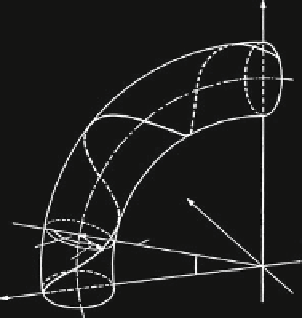Civil Engineering Reference
In-Depth Information
Fig. 3.1 Wire space curve in
bent strand, Schiffner (
1986
)
z
x
D/2
˕
r
ˑ
y
In the following chapter the theoretical evaluations of the stresses and reactions
will be again determined for the ideal rope. Thereby, it will be presupposed:
• The wire rope is of perfect geometry.
• The wire are without self-contained stresses.
• No wires or strands are loose, so that all wires start to bear when the wire rope
will be under a slight tensile force.
• All stresses remain in the elastic region.
3.1.1.2 Bending of a Strand
Important early contributions to our knowledge about bending and torsion stresses
in rope wires came from Bock (
1909
) and Woernle (
1913
). Paetzel (
1969
) and
Wiek (
1973
) were the first to establish that the stresses have to be calculated for
the difference in the space curve of the wires before and after the rope is bent. For
the space curve of the wire in the bent strand, they presented equations with a
constant ratio between the winding angle
#
around the sheave axis and the wire
winding angle u
W
around the strand axis.
Without this restriction, the equations are
x ¼
r
W
sin u
W
y ¼
D
2
cos
ð# #
0
Þþ
r
W
cos u
W
cos
ð# #
0
Þ
ð
3
:
2
Þ
z ¼
D
2
sin
ð# #
0
Þþ
r
W
cos u
W
sin
ð# #
0
Þ:
The meaning of the symbols is to be found in Fig.
3.1
. The minus in the first
Eq. (
3.2
) is valid for a right winding wire in a bent strand.

Search WWH ::

Custom Search